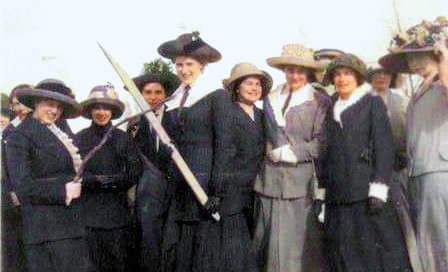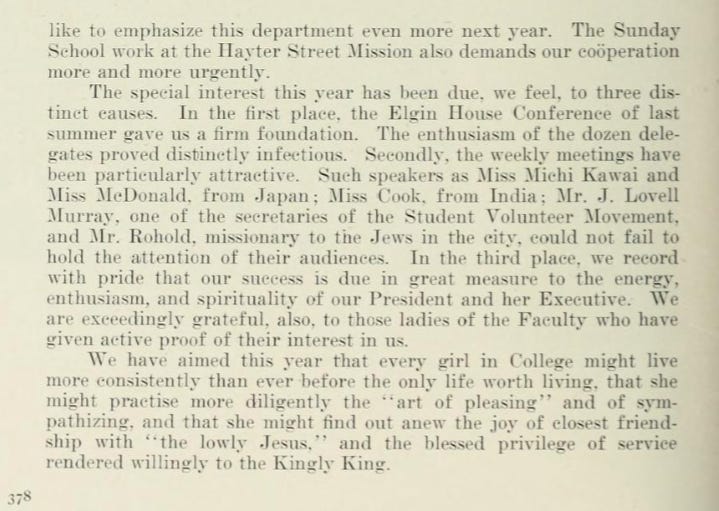I've been peering into my great-grandmother's childhood in Japan this week, along with returning to her books. As I read the range of her writing and her experience at different stages in her life, and talk to family members, I sometimes find it hard to keep up with the amount of material I could potentially review to deepen my understanding of her life in Japan, Canada, and India. The taking in, and the research, will be balanced with creation and output and living the work of poetry, and I’m brining and marinating and slow cooking (maybe even fermenting) in this creative process.
It's helping me to better understand where she was coming from and where she was going in midlife when she wrote the book that is the subject of my current literary works for performance project (thanks to the support of the Ontario Arts Council). I wondered about what developed her point of view, and curiously, an email delivered a link to just what I needed to glimpse into her growth as a young person. Looking at her University of Toronto yearbook has been illuminating, an interesting (and cover-my-mouth surprising, and smile inducing) glimpse into university culture in 1911.
I am more fully grasping how completely missionary life, evangelism, and the related culture of church and education wrapped around not only her entire career but across her whole lifespan, perhaps every aspect of her identity. This yearbook lets me see her gaze, her social group, and also a peek into the organizations that shaped her (and she contributed to) during her formative years.
It's reminded me of how many women have come before me, getting things done. Working together. Supporting each other. Working towards larger visions. Raising families. Raising up communities.
I have been thinking of where she came from, who she sought to serve, who was and was not present in the photos in the yearbook. I think about the definition of success, goodness, what is worth living for.
The photos of her childhood, taken by her father as an amateur photographer and commercial photographers, are in stark contrast to the yearbook aesthetic. That's another story, another time, but I'll say this: it's wild to have been fortunate to be able to stare into the eyes of my ancestors, on the internet. I am still amazed to be able to look into the UBC open collection and see selfies from 1880s, photos from their time in Japan. I'm grateful for the browsable online collection from my great-great grandfather's collection of glass plates and photos, the perspective and history-keeping of relatives, being able to use the internet for something that feels very very worthwhile.
Over a century later, I read some of the religious evangelical mission-driven language in the yearbook and in religious writing from the era in general, and recognize what would now be often seen as almost cultish, colonial tones, a complicated mix of sincere good wishes and misguided hierarchal assumptions. I think of the massive of amount of suffering involved on a global scale related to colonialism and religious abuse, not that I could understand the full scope to even comprehend both suffering soothed and prevented by church led efforts, and caused by church led efforts.
I’m uncomfortable trying to understand, I feel under-qualified to respond, and I have the privilege of contemplating. It’s complicated. I wasn’t there, I wasn’t a woman at the turn of the century, I haven’t been a missionary, I am in no university yearbooks, I wasn’t steeped in that context. Yet here we are, we can know so much, and we do know so much today- and what do I do with this perspective, and what do we do now in our culture? Do we even remember how much things have changed? Do we remember what hasn't changed?
Yet here is this hundred-year-old girl gang getting together because they want to be out in the world doing what they believe to be good and generous, this determined bond between young women with hopes for helping to heal their changing world, this dedication and inspiration, sisterhood and service. I wonder if I missed something in my early adulthood, and I also feel connected. I recognize the impact. I recognize women building community.
This was 1911. The women's movement was yet to happen, desegregation was yet to happen. She was yet to live through the time of world wars, the time of Japanese internment camps in western Canada, television, computers. Peter Henderson Bryce (who would become her father in law) hadn't written his report on residential schools yet. Women in Canada didn't have the vote yet when these pictures were taken. If only they'd known. If only.
Her yearbook biography aspiration of "simplicity, sincerity, service" seems to have continued through her life and in her family lineage in many ways. Though she sought simplicity in terms of sensible and practical living with enjoyment in the name of higher spiritual purpose rather than indulgence, I'm not sure I'd call much about her story simple from the perspective of lifetimes later.
Her yearbook biography says she looks forward to returning to Japan, which was her father's desire, but she ended up going to India with her husband in 1914, as newlywed missionaries. Already complexity, already adventure, already plot twists. She even remarked in a letter to her children in 1939 that she thought her life was interesting. I wonder what she'd think of this search I'm on, traipsing through her body of work, poking about her history, and whether she would agree with the character profile I'm assembling in my mind and heart. She started constructing herself, creating her body of work, collaborating with her past and her future, and I continue.
From "The Bryces of India", this paragraph is written my great-aunt, commenting on her parents’ perspectives 1939, referring to her father George Bryce promoting adult literacy:
Certainly George Bryce was encouraged to persevere in this area of education which meant so much to him. A literacy program was launched at the jail in Indore under the auspices of the Bryces' friend Colonel Samson, but conducted by a young Christian. It is interesting to contemplate the effect of learning to read on the lives of those 700 prisoners. In a family letter, Mother enthused "Don't you think it's an interesting idea to go into the prison with this program? In fact, don't you think we are in touch with many interesting things and have interesting lives? I do!" And we agreed.
Words by Lauren Best, photos from archive.org.
You can support me by buying my latest book of poetry at these links, which allow me to receive a small commission:
buy it as an audiobook or ebook from your favourite retailer
Please direct requests for interviews, collaboration, and review copies here.
I love to hear from readers! Please let me know your thoughts about this writing, and what you are still wondering about. Let me know what piqued your curiosity, and what might pique mine.
lauren’s best is a reader-supported publication. To receive new posts and support my work, consider becoming a free or paid subscriber.









